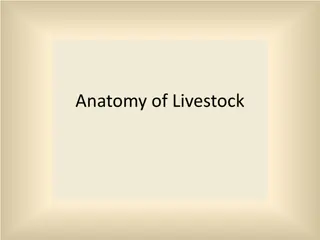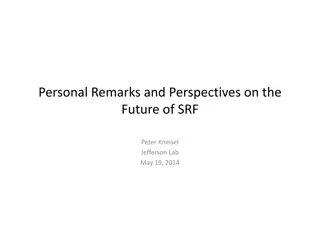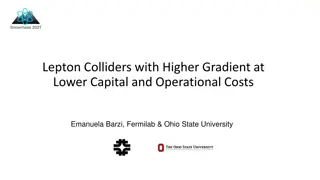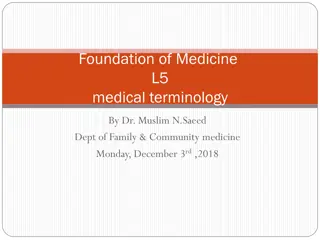Overview of ESRF-EBS 352 MHz RF System Upgrade at 26th ESL RF Meeting
The 26th ESL RF Meeting held at Elettra in Trieste discussed the status and upgrades of the ESRF-EBS 352 MHz RF system. The meeting covered topics such as the EBS RF layout, HOM damped cavities, RF ECO-Mode, ongoing RF projects, and the replacement of klystrons with SSAs for a 4th harmonic RF system
0 views • 16 slides
Understanding Gravitational Anomalies and Interpretation Challenges
Gravitational anomalies pose an inverse problem in determining characteristics of underlying bodies. Surface gravity values provide insights into geometric shape, dimensions, density contrast, and depth. Interpreting anomalies requires integrating gravimetric analysis with other geological data. Cal
5 views • 62 slides
Understanding Patterns in Casting Process
Patterns play a crucial role in the casting process by creating replicas of objects with modifications, such as pattern allowances and core prints. They help in forming mold cavities, reducing casting defects, and minimizing costs. Various materials like wood, metal, and plastics are used for patter
1 views • 15 slides
Overview of LLRF Scope and Development
The LLRF system is responsible for controlling the phase and amplitude of cavities in the linac system. The cost book details the budget for implementing the LLRF system in 155 systems. Adaptations were made to the PEG for delivering and installing the LLRF systems. A schedule outlines the developme
0 views • 8 slides
Overview of PED Compliance Requirements for RFD Crab Cavities Fabrication at FNAL
The process of ensuring PED compliance for RFD crab cavities fabricated by FNAL involves a review of EN and ASME Codes, with additional requirements set by CERN HSE. A formal agreement is being finalized, with a document defining essential safety requirements, risk assessment, and more. Additional r
5 views • 13 slides
Advanced Cryomodule Technology for China's Spallation Neutron Source Upgrade
This article discusses the development of a Double-Spoke Cavity Cryomodule for the China Spallation Neutron Source (CSNS) project. It covers the structure of the cryomodule, integration processes, future work, and details about the CSNS beam parameters and upgrade scheme. The content includes images
0 views • 19 slides
Innovative Superconducting Cavities Research Project Overview
This project, funded by the European Union's Horizon 2020 program, focuses on innovative superconducting cavities coated with superconducting films. Objectives include optimizing production procedures, testing prototypes, and reducing costs. Tasks involve coordination, strategy development, and achi
2 views • 9 slides
Understanding Livestock Anatomy and Body Systems
Explore the anatomy of livestock, including the form, structure, and systems of the body. Learn about the skeletal, muscular, sensory, nervous, circulatory, respiratory, digestive, urinary, and reproductive systems. Discover body cavities, directions, and different systems and understand the functio
0 views • 34 slides
Plastic Moulding Processes Overview
Plastic moulding processes such as extrusion, injection moulding, compression moulding, calendering, blow moulding, and rotational moulding are commonly used in manufacturing plastic products. Extrusion involves continuous shaping of thermoplastic materials, while injection moulding uses pressure to
1 views • 33 slides
Anatomy of the Diaphragm: Structure, Function, and Clinical Relevance
The diaphragm, a key muscle of respiration, separates the thoracic and abdominal cavities and plays a crucial role in breathing. This dome-shaped musculofibrous partition originates from various structures such as the xiphoid process, lower ribs, and lumbar vertebrae. Its actions are essential for t
1 views • 29 slides
Purulent Diseases of Serous Cavities: Understanding Purulent Pleurisy and Empyema Pleurae
Purulent diseases of serous cavities, specifically purulent pleurisy and empyema pleurae, are marked by the secondary nature of inflammation in the parietal and visceral pleura. The classification details the etiology and clinical variations, while the pathogenesis explains the development from vari
0 views • 31 slides
Saarvasri Baby Care Products - Nourish Your Baby's Skin and Hair
Saarvasri offers a range of baby care products to nourish and protect your baby's skin and hair. From moisturizing baby cream to soothing massage oil and hair oil, each product is infused with natural ingredients like Aloe Vera, Almond Oil, and Olive Oil to promote healthy growth and development. Th
0 views • 6 slides
Understanding Water Jet Machining in Advanced Manufacturing Processes
Water jet machining (WJM) is a cutting-edge manufacturing process where a high-velocity water jet is used to erode materials rapidly. This method involves directing a high-pressure, high-velocity water jet onto the workpiece surface, forming cavities by eroding the material. The system includes comp
5 views • 42 slides
Anatomy of the Respiratory System in Birds: A Detailed Overview
The respiratory system in birds, including poultry, consists of various components such as nostrils, nasal cavities, larynx, trachea, syrinx, air sacs, and lungs. Each part plays a crucial role in respiration, with unique features adapted to avian physiology. Understanding the anatomy of the avian r
1 views • 19 slides
Advances in Optical Bench Technology for Gravitational Wave Detectors
This content discusses the latest advancements in optical bench technology for gravitational wave detectors, focusing on precise measurements of back-scattered light, development of new optical cavities, and testing of Sagnac interferometers. Key objectives include improving suspension controls, red
0 views • 13 slides
Insights into XFEL Cavities Production and Vacuum System Challenges
The discussions at TTC Meeting in Saclay shed light on companies' experiences during XFEL cavities production, revealing operational challenges related to vacuum plants and RGAs. The use of different firm RGAs resulted in distinct effects on RGA behavior, affecting signal/noise ratio and calibration
0 views • 24 slides
Insights on the Future of SRF Technology by Peter Kneisel at Jefferson Lab
Peter Kneisel reflects on the past and present advancements in superconducting radiofrequency (SRF) technology, debunking the notion that Niobium has reached its limit. He discusses ongoing improvements in SRF cavities, surface treatments, and fabrication techniques, highlighting the need for cost r
1 views • 20 slides
Understanding Microwave Tubes and Klystron Technology
Microwave tubes play a crucial role in high-frequency applications due to their efficiency and operating principles. Conventional tubes face limitations beyond 100MHz, while efficient microwave tubes utilize electron velocity modulation for power conversion. Klystron tubes, such as Reflex Klystron,
4 views • 19 slides
Challenges in Material and Component Harmonization
The presentation discusses the challenges faced in harmonizing materials and components in the production of RF superconducting cavities and cables. It highlights the impact of standards, the tendering process, and the need for usable standards to streamline discussions and interpretations. The pres
0 views • 14 slides
RF Leakage Investigations & Atomic Clock Signal Phase Drift Analysis
RF signals ranging from 100 kHz to 150 MHz are utilized for achieving resonance in optical cavities. DC Ground Isolation Units help decouple DC grounds and shield leakage. Spectrum analysis using RF analyzers reveals peaks possibly from neighboring balun leakages. Solutions involve increasing capaci
0 views • 14 slides
Enhancing Beam Availability with ALBA LLRF Upgrades
ALBA LLRF upgrades aim to improve beam availability by implementing auto-recovery processes and feed-forward loops for RF trip compensation. The upgrades involve detuning cavities, adjusting amplitudes and phases, and enabling tuning loops to ensure smooth power delivery to the beam. Despite challen
0 views • 10 slides
Understanding Oedema in Veterinary Medicine
Oedema is the abnormal accumulation of fluid in tissues and cavities, often caused by factors like decreased plasma oncotic pressure, increased hydrostatic pressure, increased capillary permeability, or lymphatic flow obstruction. This article explores the etiology, pathophysiology, and clinical sig
0 views • 17 slides
Anatomy of the Pharynx: Structure and Function
The pharynx is a musculomembranous tube that connects the nasal and oral cavities to the larynx and esophagus. It is divided into three parts: nasopharynx, oropharynx, and laryngopharynx, each with unique features and functions. Muscles like pharyngeal constrictors and palatopharyngeus play a crucia
0 views • 31 slides
Understanding Magnetic Shielding Considerations for 3.9 GHz Cavities
This document discusses Q and magnetic shielding considerations for 3.9 GHz cavities used in the LCLS-II project, highlighting the unique behavior observed in nitrogen-treated cavities. The study delves into the improved Q values and field dependence of quality factors, challenging traditional niobi
0 views • 10 slides
Fetal Pig Dissection Lab: Observing External Features and Respiratory System
In this detailed lab report on fetal pig dissection, students are tasked with observing the external features of the pig, determining its gender, examining teeth and skin, and studying the importance of the umbilical cord. The lab also delves into the respiratory system, focusing on cartilage rings,
0 views • 24 slides
Single Cell Cavity Activity Overview
The Single Cell Cavity Activity includes ANL EP optimization, R&D cavities for various processes such as tumble, laser re-melting, CMP, ECS investigation, and manufacturing optimization. There are also activities related to Atomic Layer Deposition (ALD) cavities, traveling wave cavities, vendor qual
0 views • 4 slides
Novel Clean Assembly Techniques and In-Situ Mitigation Processes at TTC2023 Fermilab
Explore innovative clean assembly techniques, in-situ mitigation strategies, and recovery processes at the TTC2023 Fermilab event, focusing on preventing dust particle contaminations, maintaining on-line performance, understanding field emissions, and mitigating contaminations in cavities and cryomo
0 views • 4 slides
Understanding Epithelial Tissues: Structure and Function
Epithelial tissues play crucial roles in the human body, covering surfaces, lining cavities, and forming glands. They are highly cellular and rest on a basement membrane, separating them from connective tissues. Epithelial tissues serve functions such as protection, absorption, secretion, and contra
0 views • 15 slides
Importance of Oral Health and Dental Care Tips
Oral health goes beyond just taking care of your teeth; it involves maintaining your gums, tongue, and overall mouth health. Good oral health not only prevents diseases like cavities and gum disease but also contributes to your confidence, fresh breath, and overall well-being. It plays a vital role
0 views • 27 slides
Impact of Return Pressure Variation on C100 Cryomodule Performance
The performance of SRF cavities, specifically the C100 Cryomodule (CM), is influenced by the local surface resistance, bulk Nb temperature, and pressure variations. This study evaluates how return pressure variation affects the heat transfer limitations within the C100 CM, impacting cavity performan
0 views • 13 slides
Case Presentation: Kartagener Syndrome in a 24-Year-Old Male
24-year-old male patient with a history of asthma and bronchiectasis presents with worsening shortness of breath and chest pain. Neonatal history reveals Situs inversus and dextrocardia, recurrent upper and lower respiratory tract infections, while childhood history includes asthma diagnosis and chr
0 views • 24 slides
Overview of Necrotizing Pneumonia in Children
Necrotizing pneumonia in children is characterized by necrosis of pulmonary tissue, leading to the formation of small cavities containing necrotic debris or fluid. Staphylococcus Aureus and Streptococcus Pneumoniae are common pathogens. Treatment involves a prolonged course of IV antibiotics tailore
0 views • 34 slides
Advancements in Lepton Colliders Technology
Emanuela Barzi and co-authors have made significant progress in developing lepton colliders with higher gradients at lower capital and operational costs. Their research focuses on using Superconducting Nb3Sn coated Cu RF cavities, parallel-feed RF structures, and innovative technologies to achieve h
0 views • 9 slides
Quality Control and Testing Procedures for Superconducting Radiofrequency Cavities
The presentation highlights the rigorous processes involved in qualifying superconducting radiofrequency (SRF) cavities for high-performance applications. Each cavity undergoes a detailed qualification process, including BCP treatment, electropolishing, and high-pressure rinsing, to ensure optimal p
0 views • 18 slides
Booster RF 20Hz Testing & Results Summary
The Booster RF 20Hz Testing & Results conducted on October 24th, 2019 involved thermal scans and testing of power supplies and cavities for running at 20Hz. The testing highlighted concerns with power distribution and the potential for bus bars to get hot under load, requiring further investigation.
0 views • 30 slides
Minimizing Field Tilts in Superconductive Cavities: 2011 ILC Tests at FLASH
Understanding the importance of achieving flat gradients in superconductive cavities, the 2011 ILC tests at FLASH led by Julien Branlard focused on minimizing field tilts. Various solutions and test approaches were explored to address the issue, with results indicating the impact of cavity tilt and
0 views • 25 slides
SRF Cavities and Cryomodules Workshop Details
This workshop provides information on SRF cavities and cryomodules, bringing together experts to address key engineering decisions, microphonic issues, and noise reduction techniques. Attendees can expect engaging sessions, networking opportunities, and valuable insights into the latest developments
0 views • 11 slides
Development of Frequency Tuners Optimization for SRF Cavities
Frequency tuners are crucial for adjusting the fundamental frequency of superconducting RF cavities to counteract detuning effects. The proposal discusses the importance of tuners, their operational mechanisms, and the challenges in achieving high reliability for efficient cavity operation. Various
0 views • 14 slides
Major Body Systems and Cavities in Human Anatomy
Understanding the major body systems, including skeletal, muscular, cardiovascular, lymphatic, immune, respiratory, digestive, urinary, nervous, endocrine, reproductive, integumentary, and special senses systems, as well as the dorsal cavity comprised of the cranial and spinal cavities. Each system
0 views • 20 slides
Frequency and Field Resolved TEM Mode Cavity Performance Characterizations
This study focuses on the performance characterizations of TEM mode cavities with different treatments, including mid-T bakes and other processes. Investigations include the impact on Q0 and Eacc, sensitivities to magnetic fields, and strategies for improving medium field Q slope. The research aims
0 views • 19 slides







































